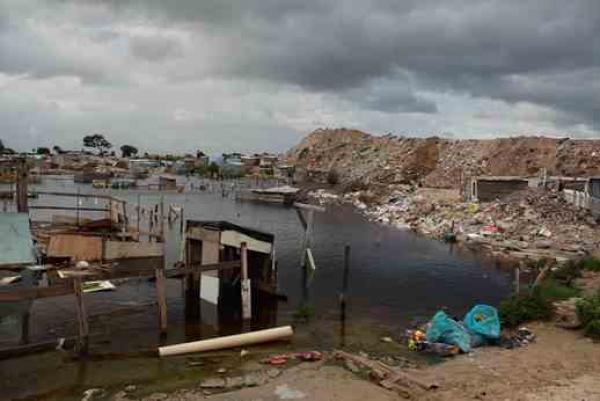

A wall of dumped rubble has created flooding in Siqalo informal settlement. Photo by Maisxole Feni.
5 August 2014
Rubble dumping on the fringe of Siqalo informal settlement has forced hundreds of shackdwellers to evacuate their homes. Boulders have rolled into shacks; dumping has prevented winter rains from draining, leaving dozens of households flooded and abandoned. Yet the dumping carries on unchecked.
It’s nearing the end of the Cape’s winter rains and the high water mark in Siqalo informal settlement has crept up to an unprecedented level. Shacks have had to be abandoned. From some, building materials have been salvaged, while others stand eerily abandoned in a dam of stagnant, stinking, knee-deep water.
“Hundreds of people have had to leave,” said Chris Doyi, a community leader who gave GroundUp a tour of the worst affected area.
One of the last remaining households in the flooded area is that of Zilungile Lisizi. Holding her eight-month-old son Anganathi, she stands in the doorway of her isolated shack which stands on a raised plot inches above of the water’s surface. Her plot is an island. An unstable passway of rubble and planks is her only point of access.
“Our neighbours have all left, but we have nowhere to go”
“Our neighbours have all left, but we have nowhere to go as a family,” she said from her doorway, as the rain started coming down.
“We build barriers against the water, and luckily our shack is a little higher than the others. But when it rains our floor gets flooded. It is not a healthy way to live. The water is dirty and my child has been coughing and sick because of it.”
The informal settlement off Vanguard Drive in Mitchells Plain regularly had problems with flooding after heavy rains in past years. But, rampant rubble dumping on Siqalo’s fringe in recent months has apparently prevented the water from draining this winter.
A seemingly endless stream of rubble removal trucks which dump on Siqalo’s fringe by day has seen the mound grow into a massive L-shaped barrier (10 metres high, 100 metres long) between Siqalo and the neighbouring land owned by Faizel Jappie.
Jappie lives on the land with his family where he runs a brick factory. He has allowed removal companies to dump on his land for free, claiming that the rubble barrier is needed for “protection” from “thieves” who threaten his family’s property and safety.
Yet, Siqalo residents claim that Jappie has gone too far and the dumping now extends well beyond the boundaries of his property.
A first line of shacks, the inhabitants of which claim to have settled with full knowledge and respect of Jappie’s property boundary, has been subsumed by the rubble.
“We used to be able to see where Siqalo property started and stopped, because there was a fence on the border,” explained Wellington Gankca, as he shows GroundUp to his abandoned shack. There are holes in the zinc walls where boulders have hit after rolling down from the mound.
Here too, among the abandoned shacks, a lonely household has resisted evacuation.
Gankca’s neighbour, Sylvia Gxogxa, hosts Sunday church congregations at an extension to the shack where she lives with her two children aged 17 and 3. The rubble pushes up against the back wall of their shack which has been reinforced and has not yet collapsed.

Sylvia Gxogxa beside her home. Photo by Masixole Feni.
“We have nowhere to go,” she sighs. “There is a plot that I know of nearby, but I have no job or money to buy new building material. Besides, this is a house of God. My congregation will die if I move this space.”
A new challenge for residents who have had to evacuate as a result of the housing is being presented by a court ordered survey, being conducted by the City of Cape Town of Siqalo.
The desperately underserviced community (there is no electricity or flush toilets for the 6000 odd inhabitants) is founded on private land. A case currently before the Western Cape High Court will determine whether the residents are to be evicted or whether they are allowed to stay.
“The City officials have come to mark shacks and register households,” said Doyi. “But, what of the people who have had to move in with neighbours and family in Siqalo. They want to be acknowledged as households on their own, but cannot because of this situation. The City must be sensitive to this, but the survey officials just shrug their shoulders when we try to explain.”
For more pictures see Masixole Feni’s photo essay.